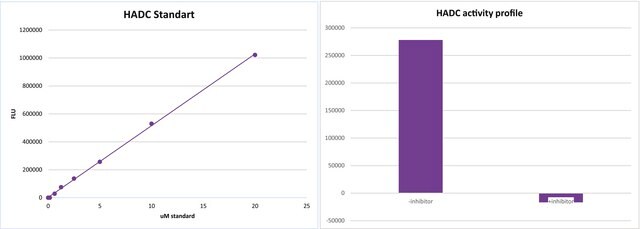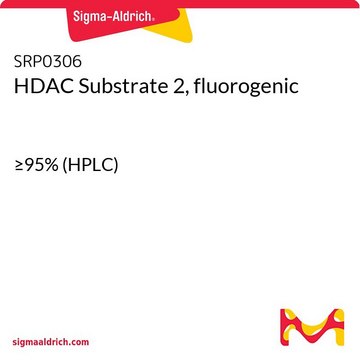EPI003
In Situ Histone Deacetylase (HDAC) Activity Fluorometric Assay Kit
100 assays in 96 well plates
Iniciar sesiónpara Ver la Fijación de precios por contrato y de la organización
About This Item
Productos recomendados
usage
100 assays in 96 well plates
shipped in
wet ice
storage temp.
−20°C
General description
Histone deacetylases (HDACs) are a large family of enzymes that remove acetyl groups from histone proteins. HDACs are localized in both the cytosol and nucleus and some shuttle between the two locations.
Sigma′s InSitu HDAC Activity Fluorometric Assay Kit provides a direct, fast, fluorescence-based method to measure HDAC activity in cultured cells. The procedure requires just two steps, both performed in the original 96-well cell culture plate. First, the cell culture medium is replaced with a cell permeable HDAC Substrate, containing an acetylated lysine side chain. During the subsequent incubation, HDAC Substrate enters the cells and is deacetylated by intracellular HDAC. In the second step, Developer is added to lyse the cells and cleave the deacetylated HDAC Substrate to release a fluorophore. The fluorescence generated can be quantified at Ex/Em = 368/442 nm. The assay is well suited for either individual or high throughput screening.
Sigma′s InSitu HDAC Activity Fluorometric Assay Kit provides a direct, fast, fluorescence-based method to measure HDAC activity in cultured cells. The procedure requires just two steps, both performed in the original 96-well cell culture plate. First, the cell culture medium is replaced with a cell permeable HDAC Substrate, containing an acetylated lysine side chain. During the subsequent incubation, HDAC Substrate enters the cells and is deacetylated by intracellular HDAC. In the second step, Developer is added to lyse the cells and cleave the deacetylated HDAC Substrate to release a fluorophore. The fluorescence generated can be quantified at Ex/Em = 368/442 nm. The assay is well suited for either individual or high throughput screening.
Application
In Situ Histone Deacetylase (HDAC) Activity Fluorometric Assay Kit has been used to determine HDAC activity.
Biochem/physiol Actions
Site specific histone acetylation and deacetylation have been shown to activate or repress eukaryotic gene transcription, respectively, and as a consequence, histone deacetylases (HDACs) play a crucial role in organism development and disease. Mutation or abnormal expression of HDAC is observed in cancer.
Features and Benefits
- Simple two-step sensitive and reliable assay
- All steps performed in the same cell culture plate
- Utilizes fluorometric method
- Sample type: cultured, adherent, and suspension cells
- Suitable for individual tests or high throughput assays and kinetic studies
- Convenient 96-well microplate format
- Suitable for screening HDAC inhibitors or activators
- Suitable for studying growth factors or other regulators that influence HDAC activity
Related product
Referencia del producto
Descripción
Precios
signalword
Warning
hcodes
Hazard Classifications
Aquatic Chronic 3 - Eye Irrit. 2
Storage Class
10 - Combustible liquids
flash_point_f
188.6 °F - closed cup
flash_point_c
87 °C - closed cup
Certificados de análisis (COA)
Busque Certificados de análisis (COA) introduciendo el número de lote del producto. Los números de lote se encuentran en la etiqueta del producto después de las palabras «Lot» o «Batch»
¿Ya tiene este producto?
Encuentre la documentación para los productos que ha comprado recientemente en la Biblioteca de documentos.
Covalent modifications of histones during development and disease pathogenesis.
Bhaumik S R, et al.
Nature Structural and Molecular Biology, 14(11), 1008-1008 (2007)
The biology of HDAC in cancer: the nuclear and epigenetic components.
Handbook of Experimental Pharmacology, 206, 13-37 (2011)
Targeting histone deacetylase activity to arrest cell growth and promote neural differentiation in Ewing sarcoma.
Souza B K, et al.
Molecular Neurobiology, 1-17 (2018)
Christina Stache et al.
Neurosurgical focus, 41(6), E14-E14 (2016-12-03)
OBJECTIVE In this study, the authors investigated the underlying mechanisms responsible for high tumor recurrence rates of adamantinomatous craniopharyngioma (ACP) after radiotherapy and developed new targeted treatment protocols to minimize recurrence. ACPs are characterized by the activation of the receptor
Long Jin et al.
Theriogenology, 87, 298-305 (2016-10-16)
Cloning remains as an important technique to enhance the reconstitution and distribution of animal population with high-genetic merit. One of the major detrimental factors of this technique is the abnormal epigenetic modifications. MGCD0103 is known as a histone deacetylase inhibitor.
Nuestro equipo de científicos tiene experiencia en todas las áreas de investigación: Ciencias de la vida, Ciencia de los materiales, Síntesis química, Cromatografía, Analítica y muchas otras.
Póngase en contacto con el Servicio técnico








